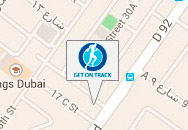Call Us Today!
04 380 55 69

Center Address :
Al Wasl Road, Umm Suqeim 3
Dubai, United Arab Emirates
Telephone : 04 380 55 69
Email : [email protected] 

Common knee pathologies
Knee pain is an extremely common complaint, and there are many causes. It is important to make an accurate diagnosis of the cause of your symptoms so that appropriate treatment can be directed at the cause. If you have knee pain, please visit our Centre for consultation and proper managment.
Arthritis
Arthritis is among the most common causes of knee pain, and there are many treatments available. Besides medication, itraarticular injection or weight reduction, the treatment of choice is physiotherapy ,.Strengthening of all muscle groups on the lower limb usually gives good result in addition to physical therapy procedure.
Ligament Injury
Ligament injuries commonly occur during athletic activities and can cause discomfort and instability.
Anterior Cruciate Ligament Injury (ACL)
Anterior Cruciate Ligament Injury (ACL) is one of four major knee ligaments. The ACL is critical to knee stability, and people who injure their ACL often complain of symptoms of their knee giving-out from under them. Therefore, many patients who sustain an ACL tear opt to have surgical treatment of this injury. ACL tears cause knee swelling and pain. Special tests place stress on the ACL, and can detect a torn ligament.
Physiotherapy and Rehabilitation is one of the most important, yet too often neglected, aspect of ACL reconstruction surgery. Rehab following ACL surgery focuses on restoring motion and strength, and improving the stability of the joint to prevent future injuries.
While general guidelines exist for ACL rehab, it is critically important that each individual progresses through their rehab as their knee allows. Progressing too quickly or too slowly can be detrimental to overall results from surgery, therefore it is important to ensure your physiotherapist is guiding your rehab.
Posterior Cruciate Ligament Injury (PCL)
Posterior Cruciate Ligament Injury (PCL) is one of four ligaments important to the stability of the knee joint. Treatment of PCL tears is controversial, and, unlike treatment of an ACL tear, there is little agreement as how best to proceed. Initial treatment of the pain and swelling consists of the use of crutches, ice, and elevation. Once these symptoms have settled, physiotherapy is highly beneficial to improve knee motion and strength. Nonoperative treatment is recommended for most grade I and grade II PCL tears .
Surgical reconstruction of the PCL is controversial, and usually only recommended for grade III PCL tears.
Medial Collateral Ligament Injury
Medial Collateral Ligament Injury is one of four ligaments that are critical to the stability of the knee joint. Symptoms of a MCL injury tend to correlate with the extent of the injury. MCL injuries are usually graded on a scale of I to III.
- Grade I MCL Tear
This is an incomplete tear of the MCL.Patients usually complain of pain with pressure on the MCL, and may be able to return to their sport very quickly, 1-2 weeks. - Grade II MCL Tear
Grade II injuries are incomplete tears of the MCL. The pain and swelling is more significant, and usually a period of 3-4 weeks of rest is necessary. - Grade III MCL Tear
A grade III injury is a complete tear of the MCL. Patients have significant pain and swelling, and often have difficulty bending the knee. Instability, or giving out, is a common finding with grade III MCL tears. A knee brace or a knee immobilizer is usually needed for comfort, and healing may take 6 weeks or longer.
Meniscus Injury
The menisci are made of tough cartilage and conform to the surfaces of the bones upon which they rest. Uneven weight distribution would cause excessive forces in specific areas of bone leading to early arthritis of knee joint. Therefore, the function of the meniscus is critical to the health of your knee.
When people talk about a cartilage tear, they a talking about a meniscus tear.
The most common symptoms of a meniscus tear are:
- Knee pain
- Swelling of the knee
- Tenderness when pressing on the meniscus
- Popping or clicking within the knee
- Limited motion of the knee joint
Any patient who has knee pain will be evaluated for a possible meniscus tear. Specific tests can be performed by your Orthopedic doctor or Physiotherapist to detect meniscus tears.
Treatment of a meniscus tear depends on several factors including the type of tear, the activity level of the patient, and the response to simple treatment measures. When surgical treatment of a meniscus tear is required, the usual treatment is to trim the torn portion of meniscus, a procedure called a meniscectomy. In all condition physiotherapy is playing important role reducing inflammation, regaining muscle power to improving affected range of motion.
'Osgood-Schlatter' Disease
‘Osgood-Schlatter’ disease is probably the most frequent cause of knee pain in children. The condition occurs most commonly in children between the ages of 9 and 16 years but it can occur in younger children. Both boys and girls are equally vulnerable to its debilitating effects. “Osgood-Schlatter” disease is always characterized by activity-related pain that occurs a few inches below the knee-cap, or patella, on the front of the knee. The child will have swelling in the area, and tenderness to touch. Sports requiring lots of running, jumping, kneeling, and squatting are particularly associated.
‘Osgood-Schlatter’ has to be properly diagnosed by the Orthopedic Surgeon then a physiotherapist can help with customized exercise programs and pain management.
Chondromalcia Patellae
Chondromalcia Patellae is a common cause of kneecap pain or anterior knee pain. Often called “Runner’s Knee,” this condition affects young, otherwise healthy athletes.
Chondromalacia is due to an irritation of the (CARTILAGE) undersurface of the kneecap. This cartilage normally glides effortlessly across the knee during bending of the joint. The treatment of Chondromalacia remains controversial, but most individuals can undergo effective treatment by resting the knee and adhering to a proper physiotherapy program.
Prepatelar Bursitis
Prepatelar Bursitis, also known as housemaid’s knee, is a common cause of swelling and pain on top of the kneecap. The name “housemaid’s knee” comes from the association of this condition with individuals whose work necessitates kneeling for extended periods of time. Treatment of prepatellar bursitis begins with avoidance of the aggravating activity. In some individuals, drainage or excision of the bursa may be indicated. In cases of infection, it is important that antibiotics are also administered
Patella Subluxacion
In some people, the kneecap is pulled towards the outside of the knee. As this happens, the kneecap does not slide centrally within its groove. Physiotherapy can help in regaining proper biomechanics of lower limb and positioning of patella in right place.
The reason for Patella Subluxacion could be weakness of hip extensors, external rotators, vastus Medialis. Appropriate assessment will help in detecting problems and planning appropriate physiotherapy approach
Knee Replacement
Knee Replacement is a surgical procedure to replace the weight-bearing surfaces of the knee joint to relieve the pain and disability of osteoarthritis. In patients with severe deformity from advanced rheumatoid arthritis, trauma, or long standing osteoarthritis, the surgery may be more complicated and carry higher risk.
Knee replacement surgery can be performed as a partial or a total knee replacement. In general, the surgery consists of replacing the diseased or damaged joint surfaces of the knee with metal and plastic components shaped to allow continued motion of the knee.
The operation involves substantial postoperative pain, and includes vigorous physiotherapy and rehabilitation. The recovery period may be 6 weeks or longer and may involve the use of walking frames, canes, crutches to enable the patient’s return to preoperative mobility